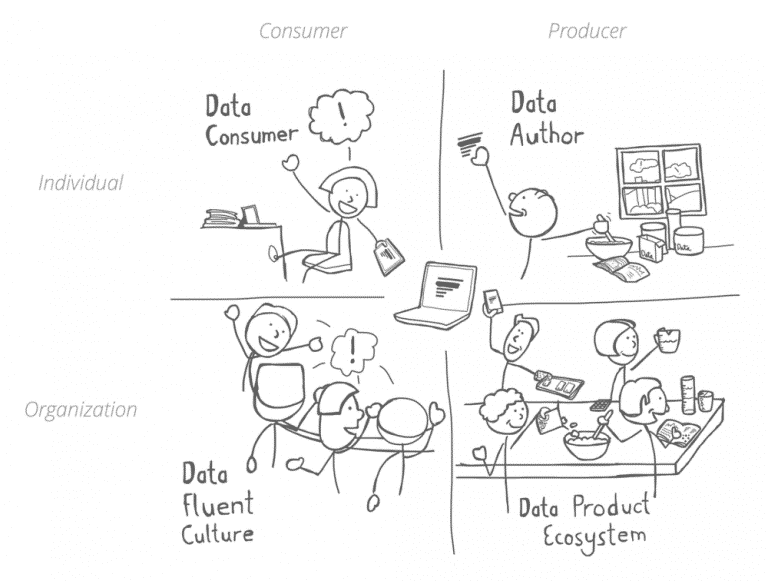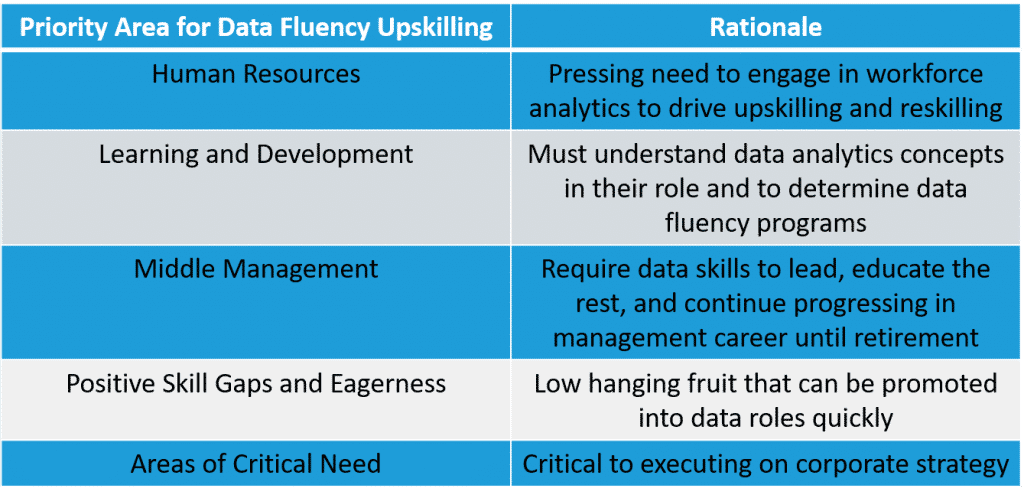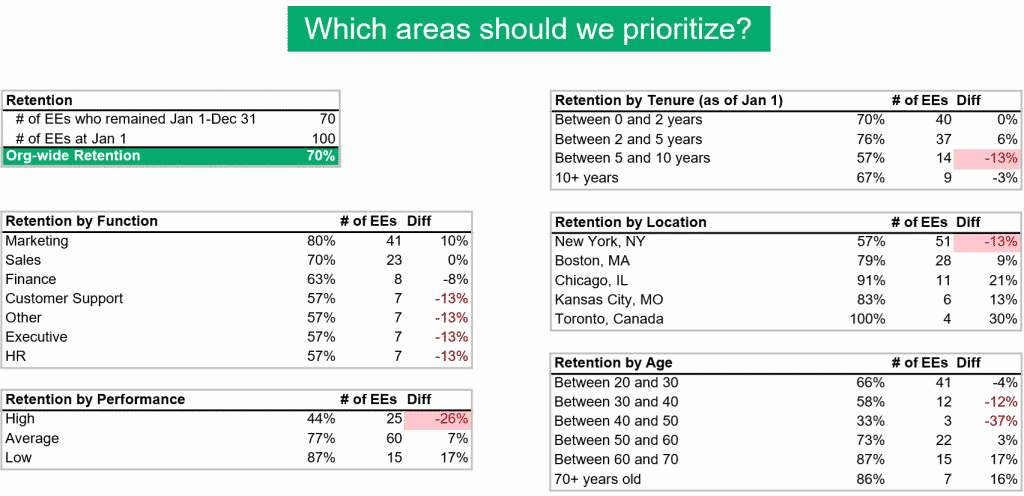Upskilling for Data Fluency is Imperative
We recently examined the pressing need to upskill and reskill the workforce for data and analytics fluency across the globe.
As a reminder, the World Economic Forum’s Future of Jobs Report 2018 predicts that automation and digitization will displace about 75 million workers and will create 133 million new jobs by the end of 2022. The majority of these new jobs will require data skills.
To prepare for the future of work and remain competitive, companies need to start upskilling their workforce for data fluency now.

One depiction of what data fluency means for the workforce (source: juicyanalytics.com)
“Data fluency” means that all producers and consumers of data across the organization, and those who are impacted by data, have an understanding of and the ability to practice data analysis.
Data fluency means that individual employees understand and draw deeper meaning from data within their respective roles and functions. It means they can apply strategic thinking and engage in dialogue informed by data concepts and that they understand the impact of data-driven strategies.
With data volumes growing by the minute, self-service analytics platforms on the rise, and trends such as people analytics gaining traction quickly, it can be tempting for companies to adopt a reactionary approach to creating a data fluent organization.
Indeed, many companies still hope to hire in data talent and skills, or they assume employees can figure out how to leverage analytics by taking a few online courses.
However, upskilling for data and analytics skills requires a planned approach in order to create a data fluent organization. Recognizing this, large companies such as Unilever and AT&T have committed to multi-year upskilling programs.
This reality begs the question, “Who should you upskill for data fluency, in what order, and how?”
In this article, we’ll make some recommendations for who to consider upskilling for data fluency, and in what priority.
Do Employees Want to Develop Data Fluency?
Yes! They look forward to it in fact. Several studies show that employees want the opportunity to be upskilled. They (rightly) view upskilling as necessary to maintaining career opportunities.
Developing new skills is so important that according to Boston Consulting Group, employees value learning and training opportunities and career development options much more than job security, financial compensation, and the interest they find in their day-to-day job.

Employees are willing to put in the time to learn data skills, too. A 2019 PwC global survey of workers found that employees are happy to spend two days per month on training to upgrade their digital-related skills such as data fluency.
In fact, employees are starting to demand more learning and development opportunities. According to Kineo found that 63% of US workers are asking for a greater focus on L&D in their workplace.
This desire to learn new skills stems from the fact that 60% of employees believe that their current skill set will become outdated in the next three to five years.
In fact, according to our partners at Pavestep, 70% of employees will leave their current company due to a lack of skills development opportunities in their existing job role.
When you take into account that, according to Pavestep, employee turnover represents about 15% of profit and costs anywhere from 60%-150% of an employee’s salary, that’s a significant argument in favor of providing your employees with the upskilling opportunities they’re seeking.
Who Should be Upskilled for Data Fluency?
The short answer is – everybody.
The fact is, however, that up to now, many employers have focused upskilling and retraining efforts on a narrow set of current highly skilled and highly valued employees.
What these companies fail to realize though is that data and analytics skills are not just for Data Scientists anymore.
A recent study by analytics database company Exasol, Data Strategy and Culture, noted that companies can only achieve data-driven status when,
“organizations employ a holistic, inclusive, and committed approach to data across the entire business and for all employees – from entry-level to the C-suite.”
To re-iterate, everyone must understand data concepts.
True, required data-related competencies and the importance of data fluency will vary according to different roles across the organization. However, most individuals must develop basic data literacy skills to respond to market and internal needs for their role.
Employees in many functions will need to be comfortable using the tools, technologies, and methods to harness the value of data.
5 Workforce Functions That Need Data Fluency Now
Unless you are Google or Amazon, the prospect of upskilling most of your organization for data skills and the associated time and cost is likely an overwhelming prospect. Where to start? Most companies will have to prioritize investment in upskilling.
We submit here 5 organizational priorities for upskilling in data fluency.

5 areas to consider prioritizing for data fluency
1. Human Resources
The ability to analyze and extract valuable insights from workforce data is an increasingly sought-after skill in HR. Because of the current talent shortage and skills gap, Human Resources is one area where the need for data fluency and analytics skills is pressing.
We recently hosted a webinar with our partners Pavestep on the need to create a data-driven HR recruitment function. The field of workforce analytics is booming.
HR, just like Marketing, Finance, and Manufacturing, is being hit with a mounting wave of data.
From candidate test scores to diversity data to retention statistics, Human Resources is an area in which data fluency is critical to driving talent management strategies – not the least of which is upskilling.
2. Learning and Development Teams
Typically, Learning and Development (L&D) teams lead the development of employee skills and competencies and work to improve the overall talent pool in the organization. They also provide employees with personal growth opportunities, which drives engagement and retention.
The Chief Learning Officer and in-house L&D experts will thus be the ones figuring out how to help employees and teams develop data fluency in their roles and on the job. Learning and development teams and instructional designers will be key drivers of organizational data fluency.
What’s more, is that workforce education itself is becoming more digitized and AI-driven. AI is being used in employee profiling, assessment, and evaluation, personalization of learning, and adaptive learning systems.
The future role of learning and development teams will itself include applying data science and advanced analytics to organizational learning.
So it follows that L&D managers must first be upskilled in data and analytics themselves, in order to ascertain how best to prepare the rest of the organization for data fluency.
3. Middle Management
As we said before, HR leaders need data skills. So does the rest of management.
Middle managers, in particular, should be upskilled for data understanding as a priority. The previously mentioned Exasol study found that 57% of corporate decision-makers agreed that middle management should drive their organization’s data strategy.
The World Economic Forum also advises that companies need to upskill middle management as a priority. These managers are at high risk of being in the 75 million displaced, yet they still have plenty of career years left and will not be able to escape the requirements of Industry 4.0 before they reach retirement.
This means that upskilling managers for data fluency should be a top priority.
4. Strategic Areas of Need
As an organization, you need to do a top-down and bottom-up evaluation of which parts of the business are most in need of data fluency in the workforce.
As an example, AT&T researched its workforce of 250,000 employees and matched their capabilities and skills with expected business growth areas. In the 21st century, data literacy is a necessary skill.
From these assessments, management determined that only about 50% of employees had the necessary math, tech, and analytics-related skills. Rather than hire a whole new workforce, AT&T decided to invest $1 billion in a multi-year upskilling initiative.
5. Positive Data Skills Gaps and Eager Employees
It is likely not possible to upskill an entire department or business unit, at first. So within key areas of the business, companies should prioritize identifying and retraining employees and managers who exhibit a strong desire to improve their data fluency and who self identify as wanting to move their roles closer to data science and analytics.
An example of this would be a market research analyst who wants to become more fluent in data science tools and technologies.
In addition, organizations should conduct assessments for data fluency and data skills to identify employees who have what we call a “positive data skills gap”. Employees with a positive data skills gap will demonstrate more knowledge of data concepts on assessments than they currently use or exhibit in their roles.
For example, a junior HR staff member may not be engaging in a lot of data analytics within their current recruitment role, but may actually be well versed in people analytics and data visualization.
Bottom Line
Whatever the role or seniority level in your organization, upskilling for data fluency needs to happen at all career stages and continuously – and it needs to start now.
Continuous learning opportunities throughout their career progression will ensure that managers and employees do not fear using data to make decisions and technology related to data analytics.
Becoming data fluent means that the workforce will rise up to opportunities for a promotion or a career change in areas of your organization that require a data-driven strategy.

